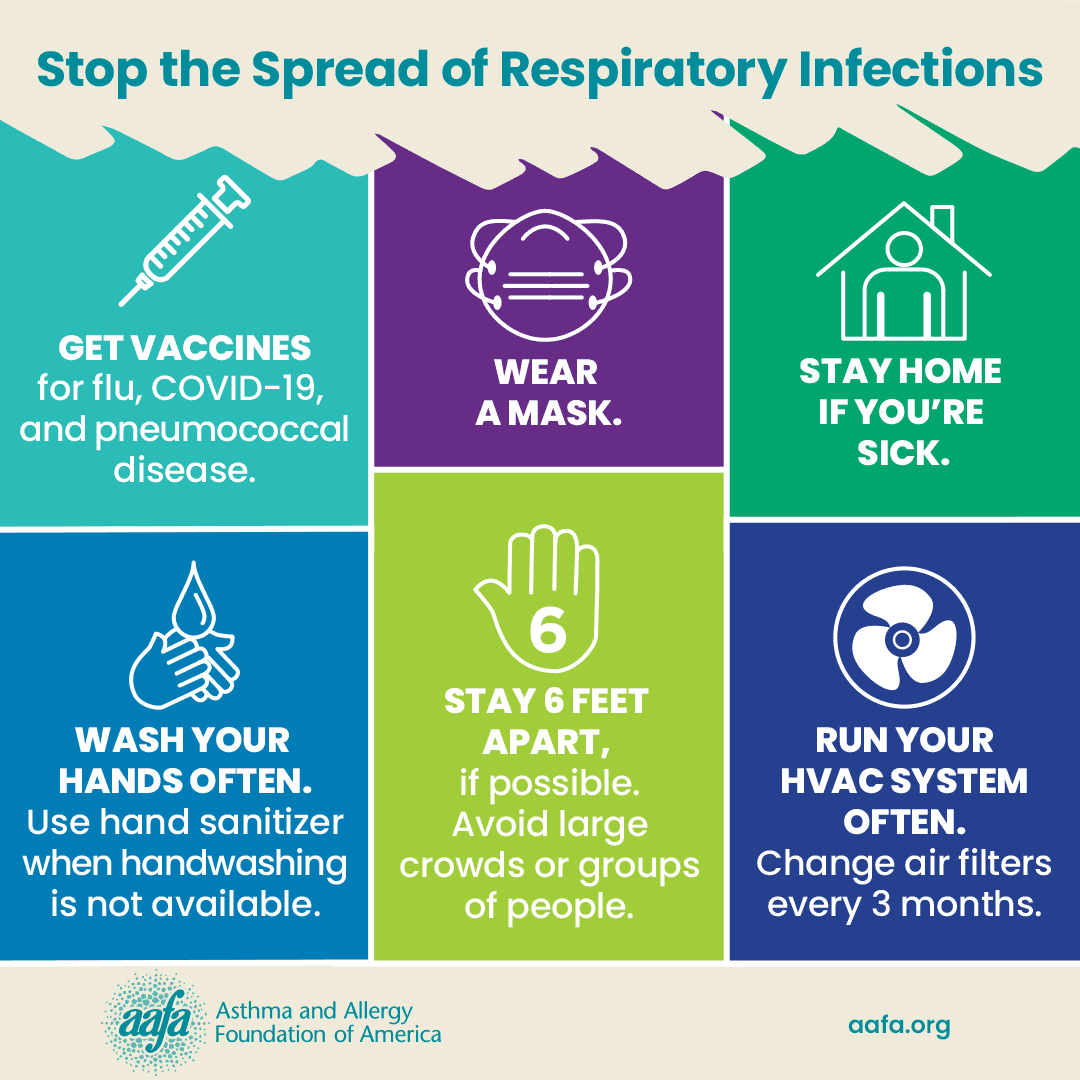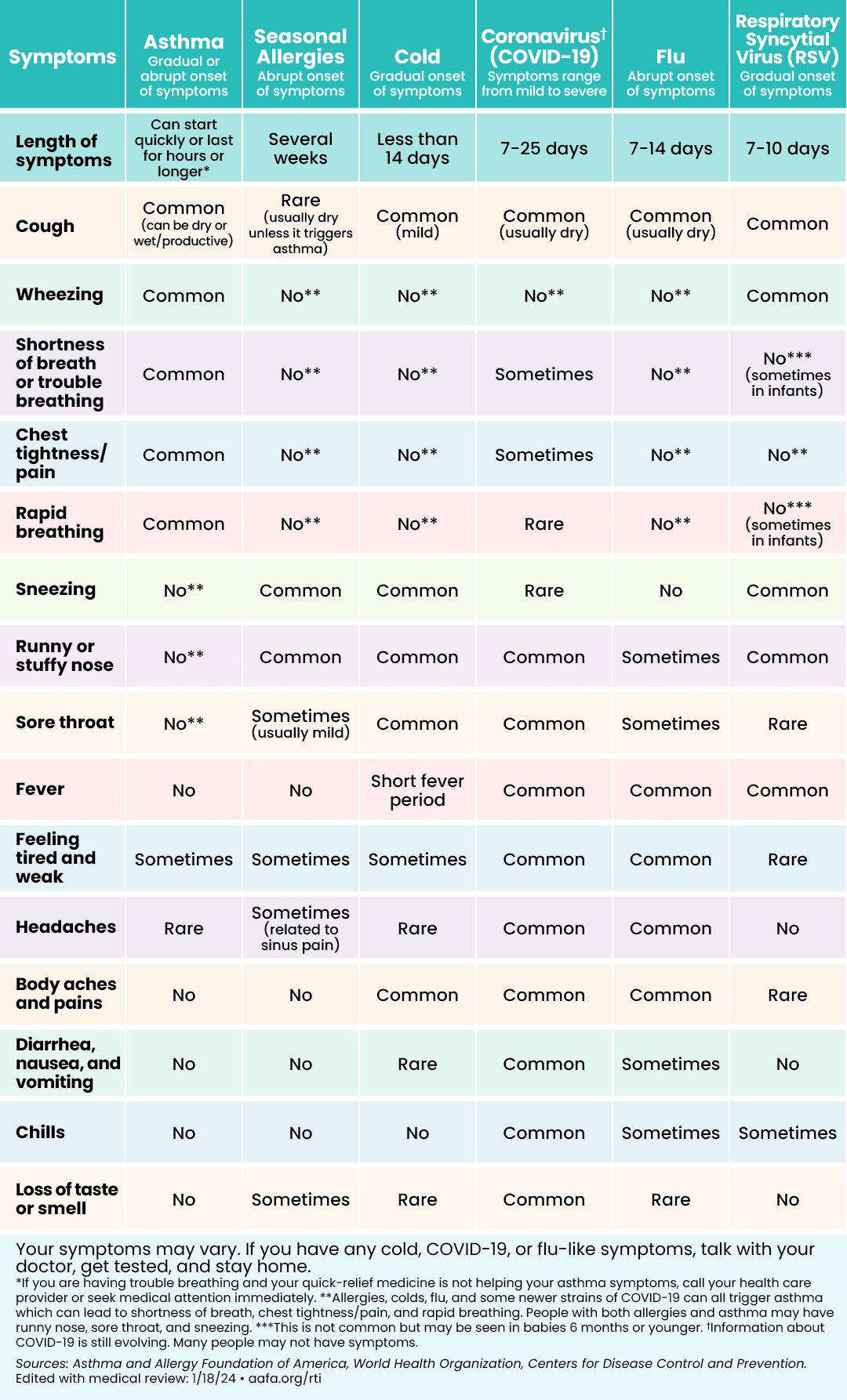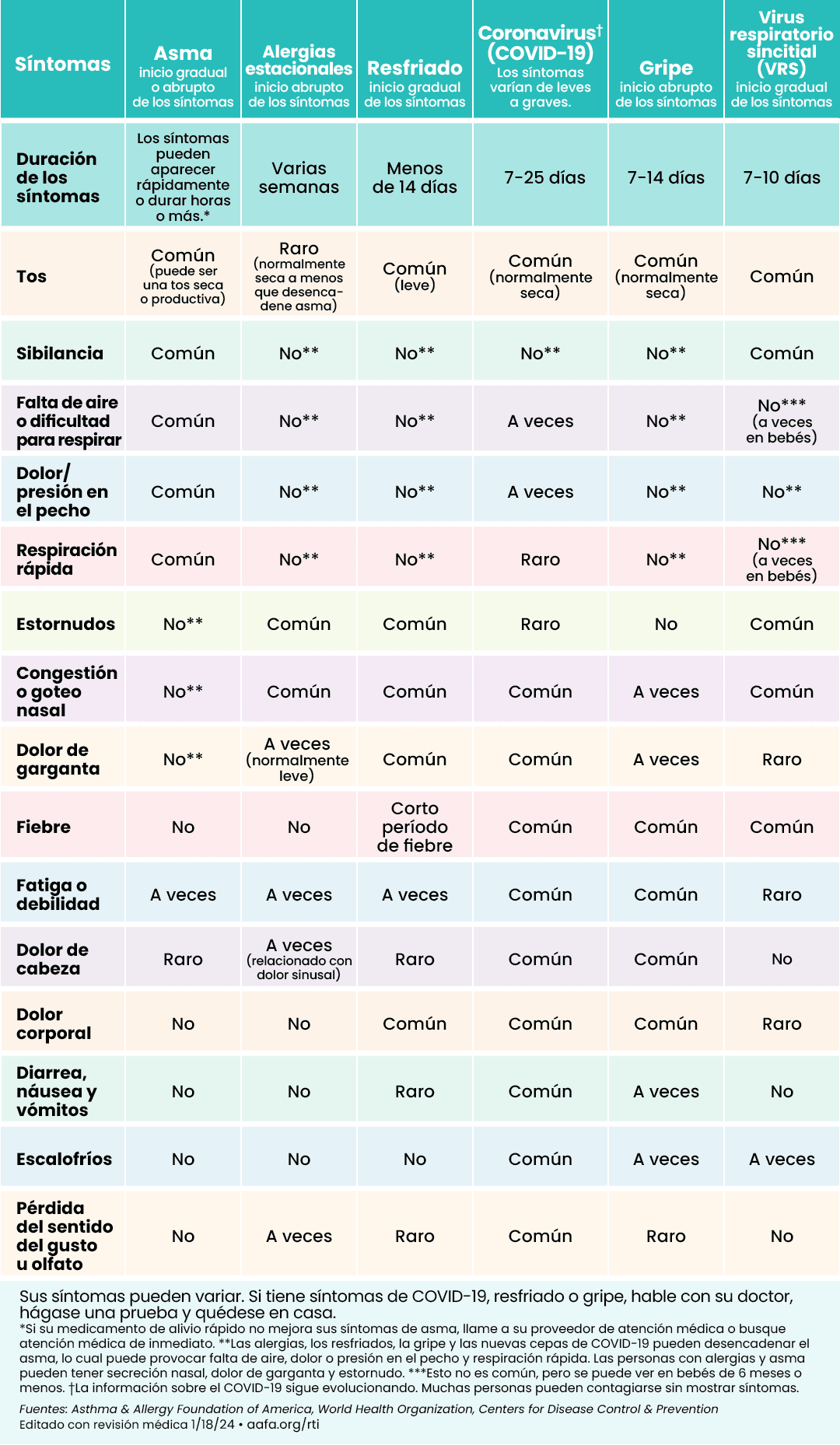Springtime pollen allergies are in full swing. With every cough or sniffle, you may wonder if it’s asthma or allergies, the flu, the common cold, or even COVID-19. But how can you tell the difference?
The Asthma and Allergy Foundation of America (AAFA) created a respiratory symptoms chart to help you recognize the similarities and differences between these conditions.
Asthma Symptoms
Asthma is a chronic disease that causes your airways to be inflamed. The best way to manage it is to take your asthma medicines, avoid your triggers, and treat asthma symptoms as soon as they occur.
Common symptoms of asthma include:
- Shortness of breath
- Cough
- Chest tightness or pain
- Wheeze (a whistling sound when you breathe)
- Waking at night due to asthma symptoms
- A drop in your peak flow meter reading (if you use one)
Symptoms can come on gradually, or they can come on suddenly.
What to Do If You Have Asthma Symptoms
At the first sign of asthma symptoms, take your quick-relief (sometimes called “rescue”) medicine. Follow the Yellow/Caution Zone on your Asthma Action Plan. The earlier you treat asthma symptoms, the better your chances are of not having an asthma emergency.
Asthma can be life-threatening, so it’s important to know the signs of an asthma emergency and to keep your quick-relief inhaler with you at all times.
Red/Danger Zone symptoms are a medical emergency. Take your quick-relief medicines right away as directed on your Asthma Action Plan and then get immediate medical attention. Call 911 or go directly to the emergency room if you have these asthma symptoms:
- Asthma is getting worse quickly
- Asthma quick-relief (rescue) medicines are not helping
- Chest tightness or pain
- Severe shortness of breath
- Breathing is faster or slower than normal
- Breathing may be hard or shallow
- Trouble walking or talking due to shortness of breath
- Chest retractions (skin sucks in between or around the neck, chest plate, and/or rib bones when inhaling; this is rare in adults)
- Ribs or stomach moving in and out deeply and rapidly
- Expanded chest that does not deflate when you exhale
- Shoulders hunched over (“posturing”)
- Cyanosis, a tissue color change on mucus membranes (tongue, lips, and around the eyes) and fingertips or nail beds – the color appears grayish or whitish on darker skin tones and bluish on lighter skin tones
COVID-19 Symptoms
The coronavirus that causes COVID-19 is a respiratory virus that started spreading worldwide in December 2019. According to the CDC, COVID-19 symptoms can include:
- Fever
- Chills
- Cough
- Shortness of breath or trouble breathing
- Feeling tired and weak
- Muscle or body aches
- Headache
- New loss of taste or smell
- Sore throat
- Stuffy or runny nose
- Diarrhea
- Nausea or vomiting
This list may not include all of the symptoms. As new variants of the coronavirus appear, the information about symptoms may change.
People age 5 and older can get a COVID-19 vaccine.
What to Do If You Have COVID-19 Symptoms
If you have any of these symptoms or if you have been exposed to someone who has COVID-19, take an at-home test or contact your doctor right away. Avoid contact with others unless absolutely necessary. Call before you go to your doctor’s office and ask for instructions. Your doctor may have a special process for you to follow so you don’t risk spreading it to other patients and staff. They may have you get tested elsewhere for COVID-19 and will give you further instruction.
If you have these severe symptoms, call 911 or go to the emergency room right away:
- Trouble breathing or shortness of breath
- Pain or pressure in the chest that doesn’t go away
- Newly confused
- Can’t wake up or stay awake
- Cyanosis which is tissue color changes on mucus membranes (like tongue, lips, and around the eyes) and fingertips or nail beds – the color appears grayish or whitish on darker skin tones and bluish on lighter skin tones
If you have to leave home for treatment, wear a face mask to prevent spreading the virus. Isolate yourself from people you live with and wear a face mask around them even at home. Clean and sanitize surfaces that are touched often like doorknobs, light switches, and cell phones.
Flu (Influenza) Symptoms
The flu is a contagious respiratory illness caused by influenza viruses. Symptoms can start suddenly and can cause mild to severe illness. It can also cause death in severe cases. Common flu symptoms include:
- Fever (often very high, 101 or above)
- Headache
- Extreme tiredness
- Chills
- Constant cough
- Sore throat
- Runny or stuffy nose
- Body aches in bones and/or muscles
- Diarrhea and vomiting (more common in children)
Thankfully, a flu vaccine is available. To reduce your chances of getting and spreading the flu, get the flu vaccine every year. The CDC recommends that people ages 6 months and older get the flu vaccine. Even if you catch a strain of flu that isn’t covered by the current year’s vaccine, getting vaccinated can make your illness less severe and lower your chance of being hospitalized.
People with asthma, as well as senior adults and people with other pre-existing conditions, are at high risk from complications from the flu.
It is important to get the flu vaccine every year. You can get the flu and COVID-19 at the same time. This increases your chance of becoming very ill. The flu vaccine also protects high-risk people you know and come in contact with, like essential workers, teachers, family and friends, pregnant women, children, and senior adults.
What to Do If You Have Flu Symptoms
If you have flu symptoms or are exposed to someone with the flu, contact your doctor right away. There are anti-viral treatments for the flu that can reduce symptoms. But you have to take them within two days of getting sick.
Like COVID-19, call your doctor before walking into their office if you have symptoms or have been exposed to the flu.
If you start having flu symptoms and have trouble breathing, start following the Yellow/Caution Zone on your Asthma Action Plan.
Cold Symptoms
The common cold is usually mild compared to the flu and COVID-19. But even a mild cold can trigger asthma symptoms, so if you catch a cold, you want to take it seriously.
Common symptoms of a cold include:
- Mild cough
- Sneezing
- Runny or stuffy nose
- Sore throat
- A short fever
- Aches and pains
What to Do If You Have Cold and Other Respiratory Symptoms
If you start having trouble breathing when sick with a cold, start following the Yellow/Caution Zone on your Asthma Action Plan. Contact your doctor if symptoms do not improve. And get immediate medical help for emergency asthma symptoms.
Allergy or Rhinitis (Nasal) Symptoms
Irritants and allergens can cause inflammation in your nose. This is called rhinitis. When your symptoms coincide with a certain season of the year, it’s commonly called “hay fever” even though it doesn't cause a fever and can be triggered by many different allergens.
Common allergens that can cause rhinitis include animal dander, dust mites, mold, and pollen.
Allergy symptoms can include:
- Itching in the nose and eyes
- Sneezing
- Stuffy nose (congestion)
- Runny nose
- Mucus (phlegm) in the throat (postnasal drip)
The inflammation (swelling and irritation) in your nose can cause it to produce a fluid called mucus. The mucus may flow out of your nose, as well as down the back of your throat. It can irritate the back of your throat and cause coughing.
Allergies are not contagious, unlike colds, the flu, and the coronavirus. They are caused by a reaction of your immune system.
What to Do If You Have Allergy Symptoms
If you have allergies, the best way to prevent or reduce symptoms is to reduce or avoid contact with the things you are allergic to. Some steps you can take include:
For dust mite allergy:
- Use CERTIFIED asthma & allergy friendly® dust mite-proof covers for pillows, comforters, duvets, mattresses, and box springs.
- Wash your bedding and pillowcases in hot water weekly to reduce allergens.
For animal dander allergy:
- Keep pets out of the bedroom to reduce pet dander allergen in your bedding.
For mold allergy:
- Run a fan in your bathroom for 15 to 20 minutes after showering or bathing.
- Fix plumbing leaks in your home.
For pollen allergy:
- Plan indoor activities on days when pollen counts are high.
- Keep your windows closed during high pollen and mold seasons. When entering your home, leave your shoes at the door.
- Wear sunglasses and a face mask to protect pollen from getting in your eyes, nose, and mouth when outdoors on high pollen days.
In general:
- Clean your floors weekly with a CERTIFIED asthma & allergy friendly® vacuum.
- Replace the filters on your heating/air conditioning units as recommended by manufacturer.
If reducing your exposure to allergens isn’t enough, there are several treatments that can help. Treatments can include nasal sprays, antihistamines, decongestants, and immunotherapy (allergy shots). See a board-certified allergist for allergy testing. They can recommend a treatment plan to help you get relief.
Uncontrolled rhinitis can lead to sinusitis, a sinus infection. If you have asthma, rhinitis symptoms can irritate your lungs and cause asthma symptoms. So if you have allergies, it’s important to get treatment to make sure they are well-controlled.
How to Reduce the Spread of the Coronavirus, the Flu, and Other Respiratory Illnesses
What can you do to reduce your chances of getting sick? To stop the spread of the respiratory infections: get vaccinated, wash hands often for at least 20 seconds with soap and water, wear a face mask when COVID cases in your community are high, and increase air flow in your indoor environment.

If you have asthma, keeping your asthma under control can reduce your chances of having a severe asthma episode or attack if you get sick.
If you do get sick, get plenty of rest, drink water, and follow your Asthma Action Plan if you have asthma.
Always contact your doctor about any concerning symptoms, no matter what. And go to the emergency department or call 911 for emergency signs and symptoms.



Comments (0)